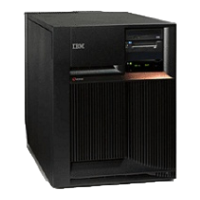v Yes: Continue with the next step.
v No: You cannot continue isolating the problem. Use the original SRC and exchange the failing items,
starting with the highest probable cause of failure (see the failing item list for this reference code in
System Reference Codes). If the failing item list contains FI codes, see “Failing items” on page 249
to help determine part numbers and location in the system.
This ends the procedure.
5. Record the SRC on the Problem summary form (see Problem summary form).
Is the SRC the same one that sent you to this procedure?
v Yes: Continue with the next step.
v No: A different SRC or reference code occurred. Use the new SRC or reference code to correct the
problem (see “Starting point for all problems” on page 2).
This ends the procedure.
6.
Determine the device unit reference code (URC) from the SRC. If the Disk Configuration Error Report,
the Disk Configuraiton Attention Report, or the Disk Configuration Warning Report display appears on
the console, the device URC is displayed under Reference Code. This is on the same line as the
missing device.
Is the device unit reference code 3020?
v Yes: A device reference code of 3020 indicates that a device is attached to the addressed I/O card.
Either it is not supported, or it does not match system configuration rules. For example, there are
too many devices that are attached to the bus. Find the printout that shows the system configuration
from the last IPL and compare it to the present system configuration.
Note: Use the unit address and the physical address in the SRC to help you with this comparison. If
configuration is not the problem, a device on the SCSI bus may be failing. Use FI code FI00884 to
help find the failing device. If you need to perform isolation on the SCSI bus, go to “SDIOP-PIP16”
on page 192.
This ends the procedure.
v No: Continue with the next step.
7.
The possible failing items are FI codes FI01105 (90%) and FI01112 (10%).
Find the device unit address from the SRC. Use this information to find the physical location of the
device. Record the type and model numbers to determine if the addressed I/O card supports this
device.
Is the device given support on your system?
v Yes: Perform the following:
a. Exchange the device.
b. Perform an IPL to DST (see Performing an IPL to DST in the iSeries Service Functions
information).
Does this correct the problem?
– No: Ask your next level of support for assistance.
This ends the procedure.
– Yes: This ends the procedure.
v
No: Perform the following:
a. Remove the device.
b. Perform an IPL to DST (see Performing an IPL to DST in the iSeries Service Functions
information).
Does this correct the problem?
– No: Ask your next level of support for assistance.
This ends the procedure.
– Yes: This ends the procedure.
198 iSeries: iSeries Server 270, 800, 810, 820, 825, 830, 840, 870, 890, SB2, and SB3 Hardware Problem Analysis and
Isolation
